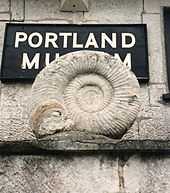Portland Museum, Dorset
Coordinates: 50°32′28″N 2°25′48″W / 50.541°N 2.430°W

Portland Museum is a local museum on the Isle of Portland, and part of the Jurassic Coast in Dorset, southern England.[1] It is located at the southern end of the hamlet of Wakeham, close to Church Ope Cove. The museum is a member of the Dorset Museums Association, whilst the museum and its two cottages have been Grade II Listed Buildings since January 1951.[2]
Overview
The museum is housed in two 17th-century thatched cottages built of stone. With both retaining thatched roofs, the cottages act as a reminder of the type of cottage that once appeared all across the island. The museum is built around four distinct themes that represent Portland most famous attributes, highlighting the history of Portland Stone, the Jurassic Coast, shipwrecks around Portland, and famous people linked with Portland. It also shows examples of the Island's rich archaeology from the Stone Ages onwards. The intention of the Portland Museum is to educate the public by providing and maintaining artefacts and specimens relating to the natural sciences, natural history, archaeology, literature, music, the fine-decorative arts, antiques and local history relating to Portland.[3]
The museum received 5,925 visitors in 2003, 5,800 in 2004, 4,220 in 2005, 5,517 in 2006, 4,750 in 2007 and 5,209 in 2009.[4] The museum has limited opening times at Easter, and is open every day during the summer (May–September), before reducing to limited opening times until November, when the museum closes until the next Easter.[5]
History

The museum was founded and first curated by doctor and pioneer of birth control Marie Stopes, who lived at the Old Higher Lighthouse at Portland Bill. The concept of a museum came to Stopes when she noticed that countless historical items across Portland's homes were often uncared for and discarded. She bought two derelict cottages at the bottom of Wakeham with the idea of creating a museum for Portland. Monies for equipment and building restoration were raised by public subscription, and after being converted and re-thatched, Stopes gave the museum as a gift to islanders in 1929. During this time the museum began accepting historical items, and first opened in 1930.[6][2][7] Stopes was the Museum's first Honorary Curator and continued a long and active association with it and its collection until her death in 1958.[8]
One of the museum's cottages, Avice's Cottage, was the inspiration behind the novel The Well-Beloved, written by Thomas Hardy, as the home of three generations of "Avices" - the novel's heroines. Hardy was a friend of Stopes.
Features
The Marie Stopes Cottage, dating back to the 17th century, features a small exhibition about Stopes, and a display of items connected to Thomas Hardy. This area also features a "Victorian Corner" which displays the wedding dress of a local Portland girl, and objects that would have been found in a Victorian parlour. In the upstairs of the cottage, the Maritime Room has a range of artifacts, including items recovered from the wrecks of 'The Earl of Abergavenny' and 'The Royal Adelaide', both lost in within Portland's waters. The Navy on Portland is also highlighted.
The Stone Room highlights Portland Stone, from the quarrying and production to its use on buildings (including war graves) all over the world. The room also features the 'Men of Stone', based on those who worked in the quarries and masonry yards on Portland. The Portland Gallery contains a collection of archaeological finds from excavations, an exhibition about Portland prisons and a cabinet displaying local glass and china items.
The Garden has a collection of local fossils, ammonites, fossilised trees and local masonry and artifacts, including the casing of the famous Portland Bomb. The garden also has seating for picnics and refreshments. The museum has a gift shop, whilst plants grown in the local area is offered for sale in the garden.[5]
Makeover

The management of Portland Museum was transferred from Weymouth and Portland Borough Council to the newly formed Portland Museum Trust on 1 April 2008. Today the trust is a registered charity. For a number of years the Council had been looking for alternative ways to deliver a number of its services, and decidedly handed over the heritage attraction to the independent trust. The Museum is managed by a Board of Directors/Trustees, each of whom has a special area of responsibility for the operation of both the Trust and the Museum. The Board also calls upon advice from a group of Special Advisers, and the team is boosted by a Museum Co-ordinator, and a growing band of volunteers.[8]
From 2009 to present, the museum continues to have a major makeover,[9] whilst the Portland Island Museum Supporters group was established in recent times as an independent and autonomous group, within the ambit of the Portland Museum Trust. The group seek to support the Museum and the Museum Trustees, and create and manage fundraising events to help enhance the experience of visitors to the Museum.[10] The museum website has been sponsored by The Skinner's Company, Lady Neville Charity.[3]
See also
- Jurassica, a proposed theme park on Portland
- Grove Prison Museum, a museum based on the active HM Prison Portland
References
- ↑ "Weymouth and Portland Borough Council". Weymouth.gov.uk. Retrieved 2013-02-16.
- ↑ 2.0 2.1 "The National Heritage List for England | English Heritage". List.english-heritage.org.uk. Retrieved 2013-02-16.
- ↑ 3.0 3.1 "About". Portlandmuseum.co.uk. Retrieved 2013-02-16.
- ↑ "Visitor numbers at selected attractions 2002-2011". dorsetforyou.com. 2012-10-19. Retrieved 2013-02-22.
- ↑ 5.0 5.1 "Weymouth and Portland Borough Council". Webapps-wpbc.dorsetforyou.com. Retrieved 2013-02-16.
- ↑ "Marie Stopes Pictures". Isleofportlandpictures.org.uk. Retrieved 2013-02-16.
- ↑ Morris, Stuart (1985). Portland: An Illustrated History. Dovecote Press. p. 126, 127. ISBN 978-0946159345.
- ↑ 8.0 8.1 "The Museum Trust". Portlandmuseum.co.uk. 2008-04-01. Retrieved 2013-02-16.
- ↑ "Portland Museum". Portland Museum. 2013-02-07. Retrieved 2013-02-16.
- ↑ "P.I.M.S.". Portlandmuseum.co.uk. Retrieved 2013-02-16.
External links
- Portland Museum - official site
| ||||||||||||||||||||||||||||||||||||||||||||||||||||||||||||||||||